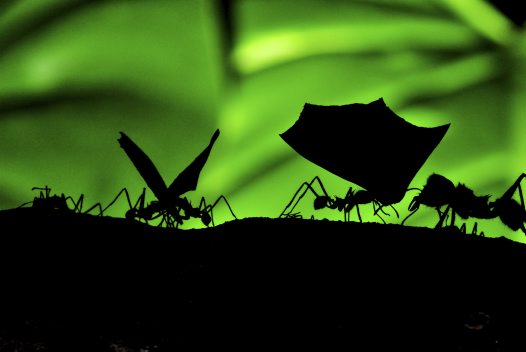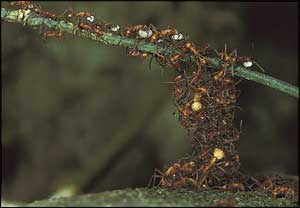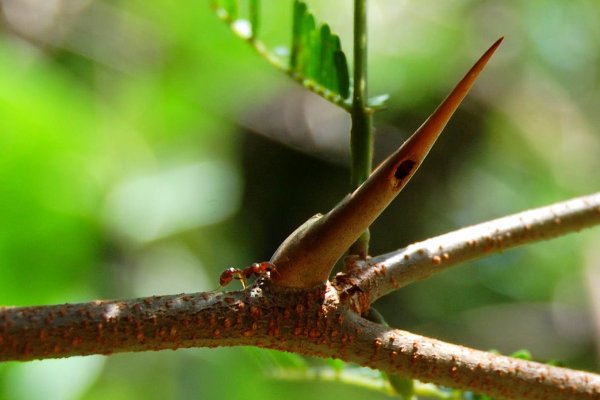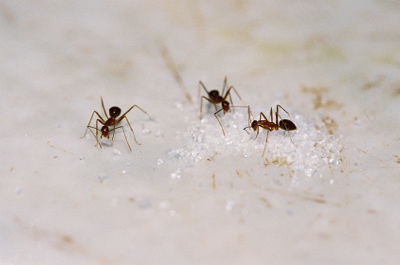Often looked at solely as pests, ants are actually extremely beneficial although they can cause us much grief. In this section I will only get specific about the most common and unusual ones and give you some tips on prevention and what to do if youíve been stung. Since we are in a rainforest you can expect that ants are as abundant as the variety of species of them and DO serve an important purpose in the balance of things.
Controlling them is a delicate thing as we do need them for several reasons. Their tunneling mixes and aerates the soil, in some places replacing the activity of earthworms. There are many ways to naturally control them so Click here for some natural preventative measures you can use to deter them from bothering you.
They are great scavengers and cleanup crews as many species feed on small insects that are serious crop pests, dead animals and insects or food dropped on the ground. This in turn is carried into their nests where it helps add nutrients to the soil. In fact some ants are fascinating and seem so highly evolved that it makes you wonder.
We also donít want to use pesticides that may harm other beneficial insects, so try to have a little patience and donít just spray the nearest pesticide. So here are things you can do to both be preventative and to get rid of existing problems, some can be used on a boat, some can be applied at the head of your dock and others are just for around the home.
Now if you are like me, something will catch your attention up in the trees and you'll stop to look, the next thing you know, you have ants crawling up your leg and biting all the way. For those of us with this problem, click here for some remedies you may want to carry around with you or may already have on hand around your house.
 Ants are social insects of the family Formicidae and, along with the related wasps and bees, belong to the order Hymenoptera. Ants evolved from wasp-like ancestors in the mid-Cretaceous period between 110 and 130 million years ago and diversified after the rise of flowering plants. They are easily identified by their elbowed antennae and a distinctive node-like structure that forms a slender waist.
Ants are social insects of the family Formicidae and, along with the related wasps and bees, belong to the order Hymenoptera. Ants evolved from wasp-like ancestors in the mid-Cretaceous period between 110 and 130 million years ago and diversified after the rise of flowering plants. They are easily identified by their elbowed antennae and a distinctive node-like structure that forms a slender waist.
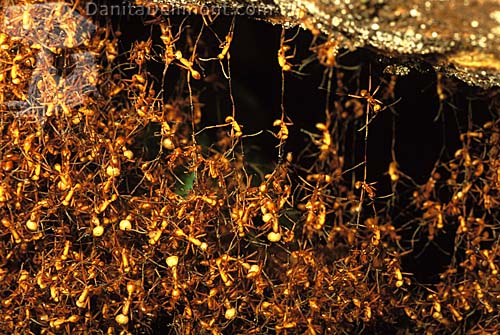 Ants form colonies that range in size from a few dozen predatory individuals living in small natural cavities to highly organised colonies which may occupy large territories and consist of millions of individuals. These larger colonies consist mostly of sterile wingless females forming castes of "workers", "soldiers", or other specialised groups. Nearly all ant colonies also have some fertile males called "drones" and one or more fertile females called "queens". The colonies are sometimes described as superorganisms because the ants appear to operate as a unified entity, collectively working together to support the colony.
Ants form colonies that range in size from a few dozen predatory individuals living in small natural cavities to highly organised colonies which may occupy large territories and consist of millions of individuals. These larger colonies consist mostly of sterile wingless females forming castes of "workers", "soldiers", or other specialised groups. Nearly all ant colonies also have some fertile males called "drones" and one or more fertile females called "queens". The colonies are sometimes described as superorganisms because the ants appear to operate as a unified entity, collectively working together to support the colony.
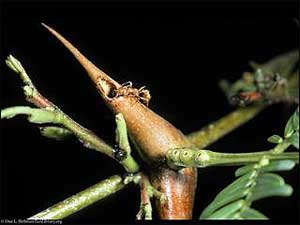 Ants have colonised almost every landmass on Earth. The only places lacking indigenous ants are Antarctica and a few remote or inhospitable islands. Ants thrive in most ecosystems, and may form 15Ė25% of the terrestrial animal biomass. Their success in so many environments has been attributed to their social organisation and their ability to modify habitats, tap resources, and defend themselves. Their long co-evolution with other species has led to mimetic, commensal, parasitic, and mutualistic relationships.
Ants have colonised almost every landmass on Earth. The only places lacking indigenous ants are Antarctica and a few remote or inhospitable islands. Ants thrive in most ecosystems, and may form 15Ė25% of the terrestrial animal biomass. Their success in so many environments has been attributed to their social organisation and their ability to modify habitats, tap resources, and defend themselves. Their long co-evolution with other species has led to mimetic, commensal, parasitic, and mutualistic relationships.
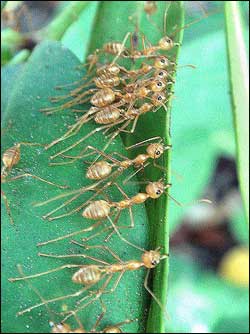 Ant societies have division of labour, communication between individuals, and an ability to solve complex problems. These parallels with human societies have long been an inspiration and subject of study.
Ant societies have division of labour, communication between individuals, and an ability to solve complex problems. These parallels with human societies have long been an inspiration and subject of study.
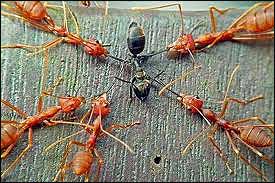 Many human cultures make use of ants in cuisine, medication and rituals. Some species are valued in their role as biological pest control agents. However, their ability to exploit resources brings ants into conflict with humans, as they can damage crops and invade buildings. Some species, such as the red imported fire ant, are regarded as invasive species, establishing themselves in areas where they are accidentally introduced.
Many human cultures make use of ants in cuisine, medication and rituals. Some species are valued in their role as biological pest control agents. However, their ability to exploit resources brings ants into conflict with humans, as they can damage crops and invade buildings. Some species, such as the red imported fire ant, are regarded as invasive species, establishing themselves in areas where they are accidentally introduced.
Gallery of amazing ant photos click here.

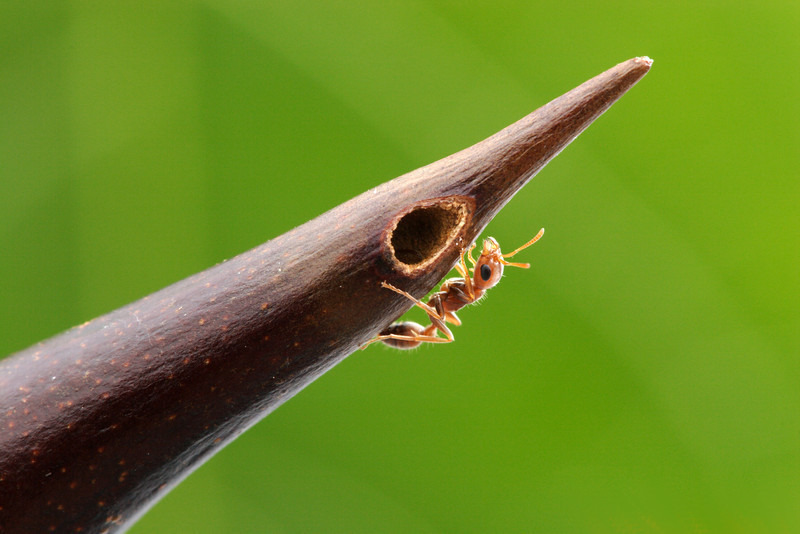
Acacia Ant
(Pseudomyrmex ferruginea)
The ants act as a defense mechanism for the tree, protecting it against harmful insects, animals or humans that may come into contact with it. The ants live in the hollowed-out thorns for which the tree is named. In return, the tree supplies the ants with protein-lipid nodules called Beltian bodies from its leaflet tips and carbohydrate-rich nectar from glands on its leaf stalk. These Beltian bodies have no known function other than to provide food for the symbiotic ants. The aggressive ants release an alarm pheromone and rush out of their thorn "barracks" in great numbers.

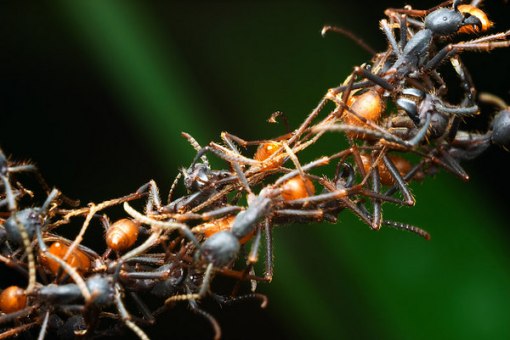
Army Ants
(Monomorium pharaonis)
Army ants are active, aggressive insects who live in temporary nests that they make by linking together their own bodies! Army ants can march 65 feet in an hour, they move their colonies regularly in search of prey that may include everything from insects to small mammals. There are about 150 species of army ants. They are found mostly in the warm tropical and subtropical regions of the Neotropics in South and Central America. Although they are blind, these tiny creatures can wipe out anything in their path. They eat other insects, snakes and small animals such as baby birds. The whole colony will overtake the smaller animal and eat it. The ants send out special scouts to look for food. When they find it they go and tell the others, then they leave a special smell that the others can follow. In East Africa they are used as natural, emergency sutures. Various indigenous tribal peoples, (e.g. Maasai moran), when they suffer a gash in the bush, will use the soldiers to stitch the wound, by getting the ants to bite on both sides of the gash, then breaking off the body. This seal can hold for days at a time, and if necessary, the procedure repeated - allowing sufficient time for natural healing to commence.

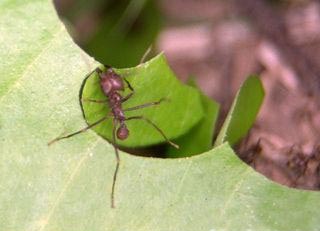
Leaf Cutter Ants
(Atta, Acromyrmex)
Ants are the most abundant insects (one hectare of rainforest contains an average of nine million ants). Though related to bees and wasps, like butterflies they pass through four life stages: egg, larva, pupae, and adult. Fairly abundant in the area and one of the more fascinating, you will see parades of ants carrying large pieces of leaves or flowers for long distances. These are the Leaf Cutter ants, click on the image above for more information.

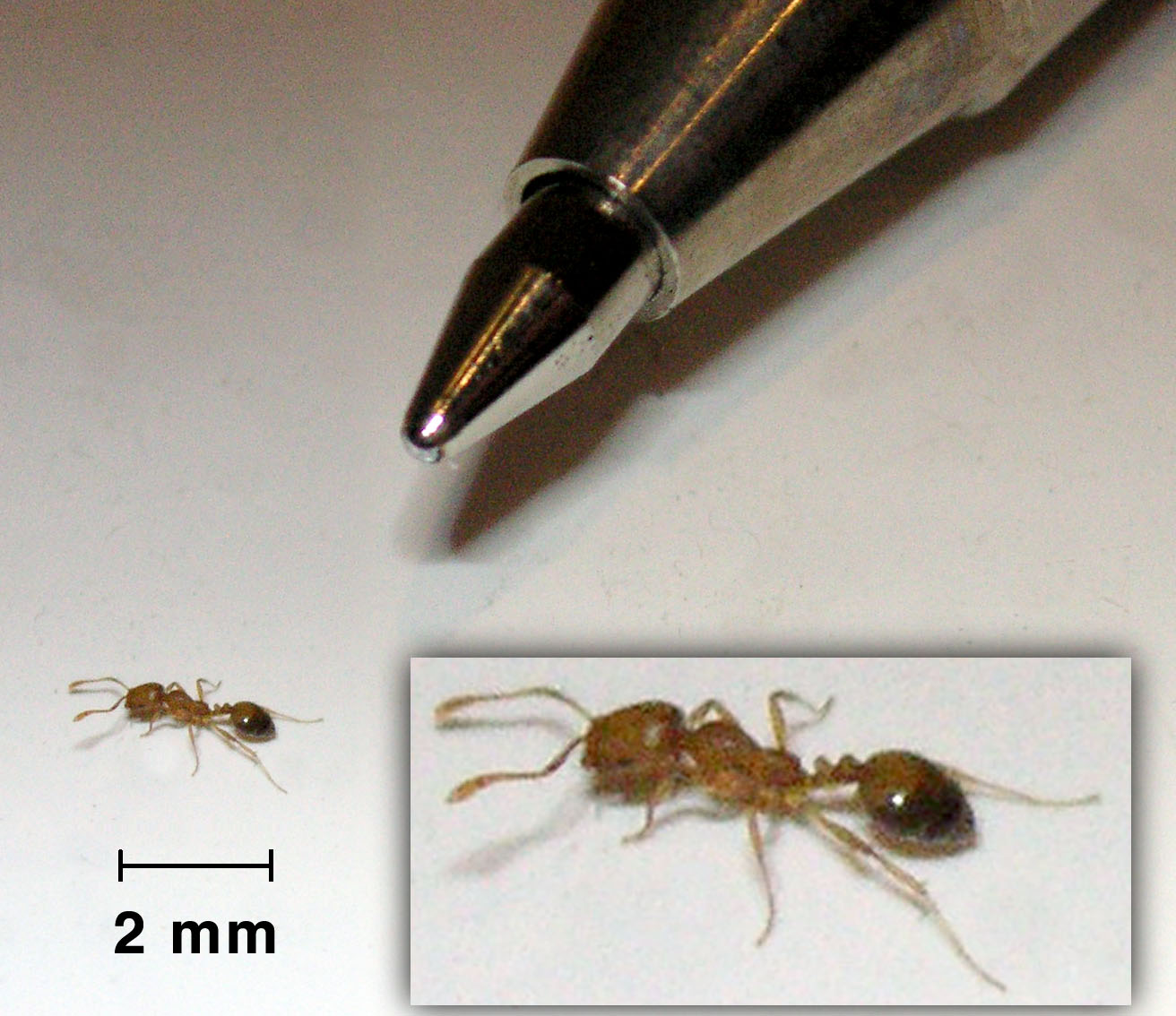
Pharaoh Ants
(Monomorium pharaonis)
Tiny Pharaoh ants are pervasive, hard to control pests that invade houses, grocery stores, and hospitals. Pharaoh ants are native to Africa, but now inhabit dwellings worldwide. They're a serious concern when they infest hospitals, as these pests carry a dozen infectious pathogens. Pharaoh ants feed on everything from soda to shoe polish, so just about anything can attract them. The name Pharaoh ant was given to this species because they were once believed to be one of the plagues of ancient Egypt. They're also known as sugar ants or piss ants.

